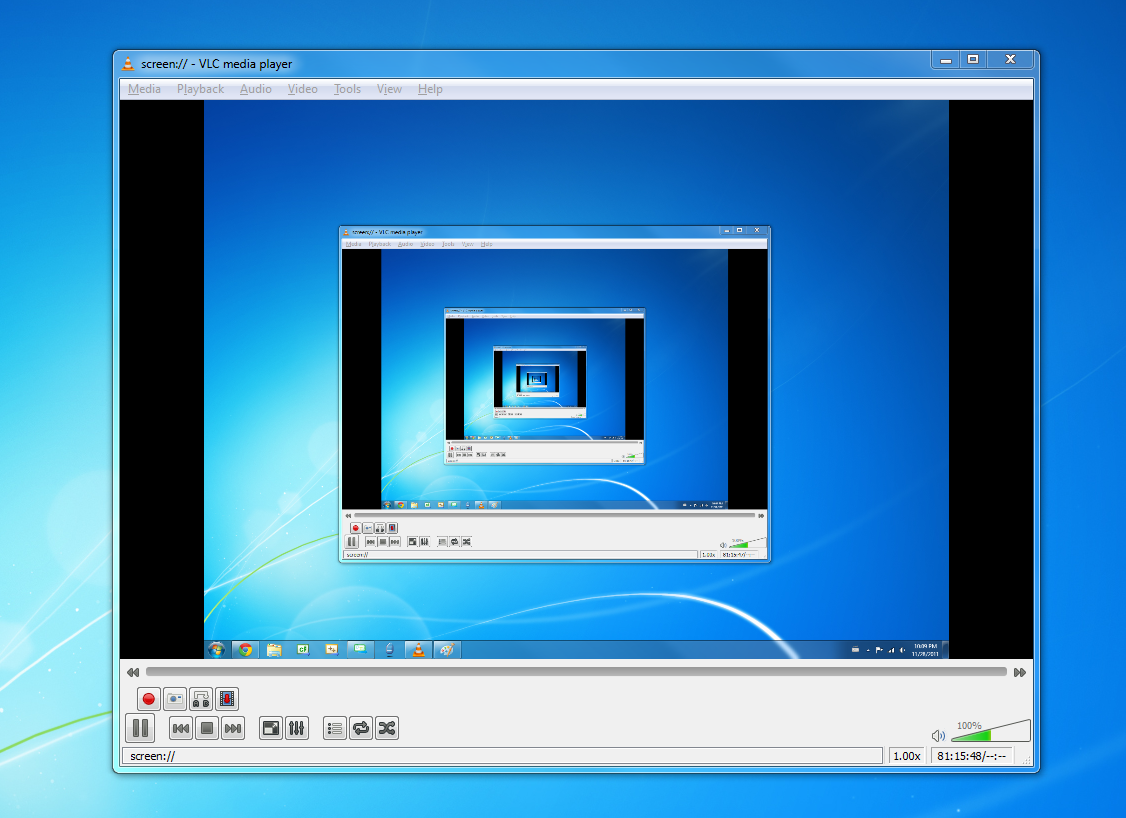Difference between revisions of "Documentation:Modules/screen"
(→Screenshot: New section (unrelated to previous example) showing File:Screen feed demo.png) |
|||
| Line 97: | Line 97: | ||
Produced a black screen... on my Fedora 12 machine. | Produced a black screen... on my Fedora 12 machine. | ||
| + | |||
| + | == Screenshot == | ||
| + | The following screenshot is unrelated to the previous demonstration. | ||
| + | |||
| + | [[File:Screen feed demo.png|thumb|left|alt=|One user created a Droste effect with a screen feed of the screen feed. Click the image to view full-size.]] | ||
{{Stub}} | {{Stub}} | ||
{{Documentation footer}} | {{Documentation footer}} | ||
Latest revision as of 09:05, 16 March 2019
| Module: screen | |
|---|---|
| Type | Access |
| First VLC version | - |
| Last VLC version | - |
| Operating system(s) | all |
| Description | screen capture |
| Shortcut(s) | - |
Stream or save a video of your computer screen.
Options
- screen-caching <integer> : Time in milliseconds
- screen-fps <integer> : Capture frames per second default value: 0
- screen-fragment-size <integer> : (Windows only) Optimize the capture by fragmenting the screen in chunks of predefined height (16 might be a good value, and 0 means disabled) default value: 0
- screen-top <integer> : The top edge coordinate of the subscreen. (New in VLC 0.9.0 on x11, New in VLC 1.0.0 on Windows) default value: 0
- screen-left <integer> : The left edge coordinate of the subscreen. (New in VLC 0.9.0 on x11, New in VLC 1.0.0 on Windows) default value: 0
- screen-width <integer> : The width of the subscreen. (New in VLC 0.9.0 on x11, New in VLC 1.0.0 on Windows) default value: <full screen width>
- screen-height <integer> : The height of the subscreen. (New in VLC 0.9.0 on x11, New in VLC 1.0.0 on Windows) default value: <full screen height>
- screen-follow-mouse, no-screen-follow-mouse : Follow the mouse when capturing a subscreen. (New in VLC 0.9.0 on x11, New in VLC 1.0.0 on Windows) default value: no-screen-follow-mouse
- screen-mouse-image <filename> : (Windows only) Mouse pointer image to use. If specified, the pointer will be overlayed on the captured video. (New in VLC 1.0.0) default value: ""
screen-mouse-image notes: - The registration point is (at least by defualt) at the top left corner of image. - File location is relative to your VLC installation folder
Run...
% vlc -H
...for the definitive options for your version.
Example
Capture a screen:
% vlc screen:// --screen-fps=1 --screen-width=100 --screen-height=100
The screen thus captured is 100x100 pixels in from the top left corner of the active screen.
Show mouse on screen:
% vlc screen:// --screen-fps=30 :screen-mouse-image=file:///c:/cursorimage.png
Questions
How to save? Where is the file saved?
Example of a file save (:file{dst=D:\\savedir.mp4}):
% vlc screen:// :sout=#transcode{vcodec=h264,vb=0,scale=0,acodec=mpga,ab=128,channels=2,samplerate=44100}:file{dst=D:\\savedir.mp4} :sout-keep :screen-mouse-image=file:///c:/cursorimage.png
How to get audio to work?
On a dual head monitor, how to make sure the recording is happening on target monitor?
Commands I've used
vlc screen:// --dshow-fps=29.950001 --nooverlay --sout #transcode{vcodec=h264,vb=800, scale=0.5,acodec=mp3,ab=128,channels=2} :duplicate{dst=std{access=file, mux=mp4,dst=/home/user/Desktop/test.flv}}
Produced a black screen... on my Fedora 12 machine.
Screenshot
The following screenshot is unrelated to the previous demonstration.
Please read the Documentation Editing Guidelines before you edit the documentation
